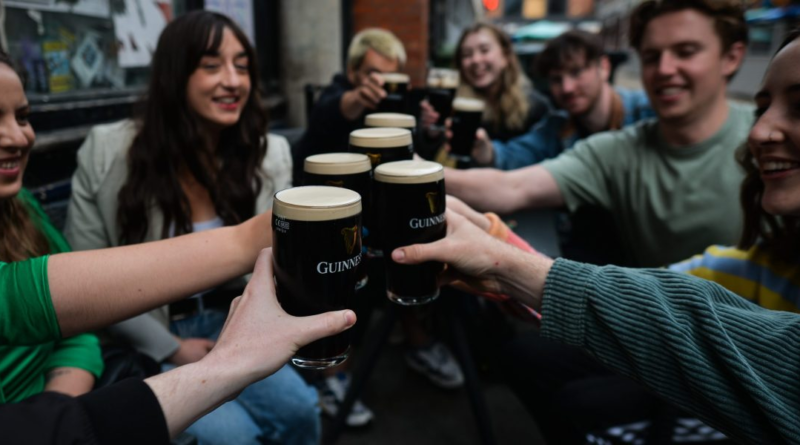Guinness is entering a 'golden age' thanks to social media-obsessed millennials
If you’re in London this St. Patrick’s Day, you’re likely to find a decent-quality Guinness within a few hundred meters.
But it wasn’t always that way.
The drink that dates back to 1759 is entering its “golden age” and defying an industry setback faced by other brewers amid a rush for “premiumization” by leaning into its own form of premium: that of dominating the social media landscape.
It has scared bartenders into the perfect pour and ultimately propelled Guinness to remarkable growth, and the brewer isn’t resting on its laurels.
A ‘good’ Guinness
It’s easy to tell how nice a Guinness is likely to taste just by looking at it, admittedly after a bit of committed practice.
A well-poured Guinness will have a creamy, domed head that is not too large and not too small. When tilted, that head should be able to stand up under its own weight on the side of the glass, passing what is described as the “tilt test.”
It shouldn’t be too cold either, with Guinness recommending a pint be served at a balmy 6-7 degrees Celsius (around 42.8 degrees Fahrenheit). Traditionalists cringe at the company’s “Extra Cold” version, which comes in a few degrees Celsius cooler.
There are a few reasons why a pint of Guinness can vary in quality. The distance the Guinness travels along that pipe is important. One bar that serves less Guinness is likely to taste worse than one that serves more because Guinness is best when served fresh.
It’s a fairly exhausting and emotion-inducing process to create a pint—no other brewer can compete with the level of detail that goes into pouring it or the free marketing that its debate incites among its customers.
Mark McEvoy, a Dublin-born landlord of the Three Crowns pub in Old Street, London, puts more effort into his Guinness than any other drink.
And for good reason. McEvoy says the bar sold more than 18,000 pints of Guinness last year, more than double its next most popular drink, Camden Hells lager.
He says interest in the black stuff has seen a huge rise in the U.K. capital in recent years—his pub didn’t even have the drink on tap when he moved five years ago.
Bartenders in the city rarely abided by the arduous process of pouring a Guinness, including the fabled “two-part pour,” but he says that has changed.
“A lot of that has to do with people taking pictures on social media,” McEvoy told Fortune.
“I think the quality has definitely improved in the last couple of years, I notice more and more bars are paying attention to the quality of the serve.”
In addition to ensuring the conditions are in place for a good pour, McEvoy has to train bartenders across the city to make sure they do it right.
Guinness’s exclusivity
While a headache for bartenders, the quality-based exclusivity of Guinness is a big part of its charm, particularly for customers who value effort and authenticity in their products more than ever.
Indeed, Guinness continues to be a growth driver for the company, with sales increasing by 24% in Europe last year, according to the latest interim results. It has enjoyed half-yearly double-digit growth for six consecutive years.
It may be no coincidence that those six years have coincided with mushrooming internet subcultures following the rise of TikTok and innovations in short-form video content from YouTube and Instagram.
Daragh Curran found huge success with a YouTube page called the “Guinness Guru,” where he would travel around cities in the U.K., Ireland, and abroad sampling the good, the bad, and the ugly of Guiness-serving pubs.
“I had a feeling, I was like “I just think there’s something in this,” Curran told Fortune of his hunch that Guinness content would find a social media audience.
Soon views started pouring in as he became a de facto Guinness tourist guide.
He says that after he filmed a visit to the Guinea Grill, an upmarket pub in Mayfair, London, he was told sales of Guinness had jumped 50%. Similar phenomena have happened in his highest-rated pubs across the U.K. and Ireland, like Mulligan’s in Manchester and Bittles Bar in Belfast.
Millennial appeal
It’s people like Curran who hold the secret to Guinness’s success.
The brand’s mystique means it has availed of free marketing from cool sections of the internet without spending a penny.
“It was always, culturally, a huge part of Ireland, but now the 18-25 year old has been massively impacted. Young people are drinking Guinness because it’s all over social media,” Curran says.
There are parallels between Guinness’s renaissance and the growth of craft beer, as the drinks’ artisanal reputation won it plaudits with millennials over the last decade. The Three Crowns’s McEvoy thinks that has tailed off in place of Guinness.
An Instagram page titled “Shit London Guinness” popped into the mainstream a few years ago as its creator pointed out the grim end of the drink’s quality spectrum across the U.K.’s capital, something that appears to have only made it more appealing.
Meme pages on social media accounts for trendy East Londoners often reference the local’s increasing fondness for a Guinness, poured at one of the area’s several charming pubs.
Guinness says it has all dovetailed into an increased pickup of millennial drinkers between 25 and 44.
Demand among women, not a classic target demographic for Guinness, has also increased and broadened the drink’s appeal. Guinness says it saw a 24% rise in female customers last year.
Stephen O’Kelly, Guinness’s global brand director, says there hasn’t been any big marketing push from the brand in recent years, certainly nothing like the iconic television commercials it launched in the early 2000s.
O’Kelly says the last five years in particular have been “remarkable” for the brand’s growth.
“Our brand purpose is about celebrating the power and goodness of communion and these values combined with the beauty of the pint, the distinctive taste, and commitment to quality of the liquid have taken the brand to new heights and what we describe as a golden age of Guinness,” Kelly told Fortune.
Guinness has found ways to appeal to non-drinkers, with the rollout of its alcohol-free “Guinness Zero” poised to appeal to sober-curious Gen Z.
But as long as it can continue to lean on viral posts from its fans, Guinness’s owners Diageo might continue to reap in double-digit growth.




